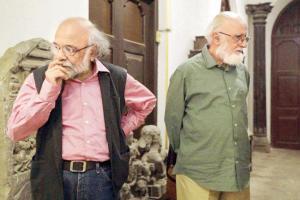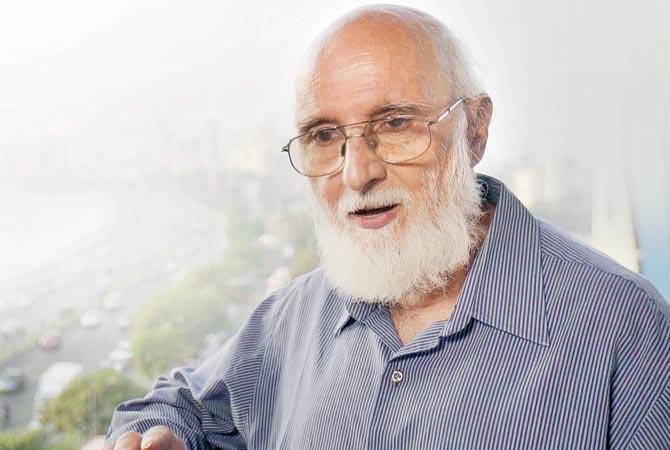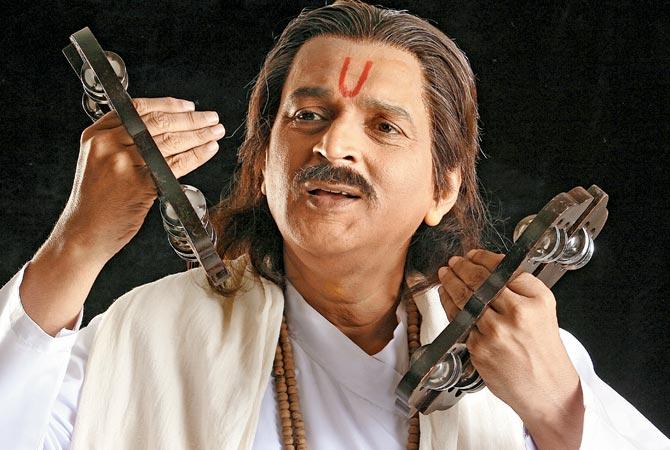Poet-playwright-academic Sitanshu Yashaschandra u00c3u00a2u00c2u0080u00c2u0094 chosen for the Saraswati Samman - on how the term 'regional writer' is claustrophobic to someone with interests as varied as his

Yashaschandra with Prabodh Parikh during the shooting of the documentary on the former
 To be given the Saraswati Samman, which entails a cash prize of R15,00,000, elates 77-year-old Gujarati poet-playwright academic Sitanshu Yashaschandra Mehta. But there is a piece of coinciding news that is even more empowering — the Oriya, Bengali, Hindi and Marathi translations of his anthology, Vakhar, which got him the honour, are due for publication. To top it all, a one-hour documentary on Yashaschandra, Aa Manas Gujarati Laage Chhe, (the title "This man looks like a Gujarati" takes after his play Aa Manas Madrasi Laage Che) will precede the end-of-the-year Saraswati Samman award ceremony. It has been made by another Gujarati poet and visual artist, Prabodh Parikh, who has followed Yashaschandra's work over the years.
To be given the Saraswati Samman, which entails a cash prize of R15,00,000, elates 77-year-old Gujarati poet-playwright academic Sitanshu Yashaschandra Mehta. But there is a piece of coinciding news that is even more empowering — the Oriya, Bengali, Hindi and Marathi translations of his anthology, Vakhar, which got him the honour, are due for publication. To top it all, a one-hour documentary on Yashaschandra, Aa Manas Gujarati Laage Chhe, (the title "This man looks like a Gujarati" takes after his play Aa Manas Madrasi Laage Che) will precede the end-of-the-year Saraswati Samman award ceremony. It has been made by another Gujarati poet and visual artist, Prabodh Parikh, who has followed Yashaschandra's work over the years.
Yashaschandra says the joy of being made available in multiple Indian languages, in print and on celluloid, is a heartwarming validation, more so when his literary corpus — 10 plays, three poetry anthologies, and three critical analyses — is not directed at a regional Gujarati sub-culture, but factors in a pan-Indian reader. In fact, he resents the label of a regional writer as he has adapted varied world texts in Gujarati — Eugene Ionesco's The Lesson, Thomas Hardy's Day After The Fair and Peter Shaffer's Equus. The subjects that pique his curiosity include 'Simon-Go-Back'-brand freedom fighter Yusuf Meherally, Vietnamese revolutionary Ho Chi Minh, Kosovo President Ibrahim Rugova. Of the three, only one is a Gujarati, he chuckles.
ADVERTISEMENT
 Before shifting to Baroda, Sitanshu Yashaschandra lived in Girgaum and later Juhu. He taught Gujarati and English at Bhavan's and Mithibai College
Before shifting to Baroda, Sitanshu Yashaschandra lived in Girgaum and later Juhu. He taught Gujarati and English at Bhavan's and Mithibai College
"The horizon of experience of the so-called regional Indian writer, has always been larger than the limits of the sub-region in which he or she is rooted, in my case Gujarat. Indians share their linguistic-cultural traditions even without knowing that they borrow from and contribute to each other," he observes while declaring overt pride in the "large catchment area" available to Indian writers. For him the Saraswati Samman "is more epistemological than literary", as it is a reminder that the 'regional' is to be celebrated, it is not narrow in scope in a country of 29 closely-knit states, some as vast as certain European nations. "A region-specific Indian writer doesn't miss out on readership, rather automatically gains entry into a porous reader-peer circle that exists despite the poor attention given to the linkages between native languages."
Yashaschandra's Vakhar, (rendered as Godam in Hindi) is a dialogue between a retired BSF Jawan and an unseen-and-unconcerned authority. The former complains about a suspicious warehouse in his basti; but the authority doesn't do much to inspect the insides of the silo. In a cluster of eight free-verse compositions, Yashaschandra underlines the attitude and behaviour of plush neighbourhoods towards slum settlements. "Identify one Indian city where bastis are not used as dumping grounds by the civic establishment. The jawan is the worldwide symbol of the helpless citizen who can only complain," he observes. Similarly, his poem on Baroda's polluted Vishwamitri river, exudes a universal appeal. The English translation, by Yashaschandra himself, seem to be a tribute to Mumbai's Mithi: "Though, if you thought of it/ She too might have once been a river/ Just as Ganga, Seine, Volga, Nile, Thames, Hoang-ho, Mississippi, Amazon/ All are Rivers/ She, too, was, perhaps, one."

Utkarsh Mazumdar playing poet Narsinh Mehta in a play written by Yashaschandra
It's not surprising that Mumbai resonates in Yashaschandra's identity as a poet-playwright. Before shifting to Baroda, he lived in Girgaum and later Juhu, teaching Gujarati and English in the Bhavan's and Mithibai College; not to forget his association with the St Xavier's college as a student of Gujarati and Sanskrit literature. Despite his stints in the US and France — on the Fulbright and Ford fellowships — Mumbai remained central to his creative impulses. His play Aa Manas Madrasi Laage Che enjoyed a popular run in Mumbai at a crucial juncture when the Emergency had been lifted. Mounted as an inter-collegiate production by none-else but the late Satyadev Dubey, along with co-director Utkarsh Mazumdar, the play was a telling comment on how people form unfair, unsubstantiated impressions about others. A Gujarati is mistaken for a Madrasi (again a funny hold-all term for those hailing from South India) by his fellow Gujaratis, merely because he speaks differently. Yashaschandra, then a young US-returned family man living in the JVPD scheme, recalls the play as a symbol of a yesteryear innocent Bombay. "The city had retained its creative juice despite the brush with the evil face of power during the Emergency; I feel Mumbai gained its belief in goodness in that period. For me, Aa Maanas brings back memories of life in Juhu which had large water-logged fields where white birds perched on lazy loitering black buffaloes."
Aa Maanas rehearsals gave rise to much off-the-stage fun in Mumbai's theatre circles. Member of the Gujarati academia often dropped in to see Dubey's dynamic direction. One of them was shocked by the scene in which Chhokari, the girl, waits outside the male urinal to hear the sound of the Madrasi saheb's piss, so as to assess if it was a native Gujarati sound or a Madras-returned alien drip. Unable to take the joke, the fellow academic advised Yashaschandra to eliminate the "ashleel dialogue" and avoid the possibility of a disciplinary action he may invite as a college lecturer. The playwright did not cut out the p*** scene! Aa Manas completed over 50-odd shows (in all prestigious Mumbai venues; was invited to the US for the Gujarati diaspora) and never posed a risk to his job or his stature. His anthology, Jatayu. received the Sahitya Akademi award in 1987, and he was honoured with the Padma Shri in 2006.
Yashaschandra's musical experiment featuring the Gujarati saint-poet Narsinh Mehta, known for the iconic Vaishnav Jan To Tene Kahiye Je, also has had a great run in Mumbai. While director Utkarsh Mazumdar performs it under the title of Jagine Joun To, it was rather radically named Nakkamo Manas Chhe Narsinh Mehta (Mehta is a good-for-nothing guy), 2008 — which obliquely brings out the playwright's high regard for the forgotten yesteryear rebel who loved Lord Krishna on his own terms. As theatre luminary Naushil Mehta says: "There could not have been a better ambassador for Narsinh Mehta than Sitanshubahi. For an adi kavi whose take against orthodoxy and caste system is too much to digest for today's Gujarati enthusiasts, and whose intense lyricism requires successive readings, one needs a culture interpreter, not a mere writer, who can do justice to an enigma…" Jagine Joun To has been written in the meter that Narsinh Mehta espoused.
Yashaschandra sees Indian literature as offering solutions to most current-day problems, particularly in the Indian identity crisis department. He sees the crisis emerging from the unaddressed devastating loss of freedom and dignity of Indian literature. "As a people, we need to tap into our Sarva Bhasha Saraswati, which lies not in branded litfests or any market-driven glitter, but it is in our languages." He feels writers should never be displayed as celebrities, as that obviates an intimate and equal relationship with their sahridaya (empathiser). They should be writers without being seen as being so!
Sumedha Raikar-Mhatre is a culture columnist in search of the sub-text. You can reach her at sumedha.raikar@gmail.com
Catch up on all the latest Crime, National, International and Hatke news here. Also download the new mid-day Android and iOS apps to get latest updates
 Subscribe today by clicking the link and stay updated with the latest news!" Click here!
Subscribe today by clicking the link and stay updated with the latest news!" Click here!







